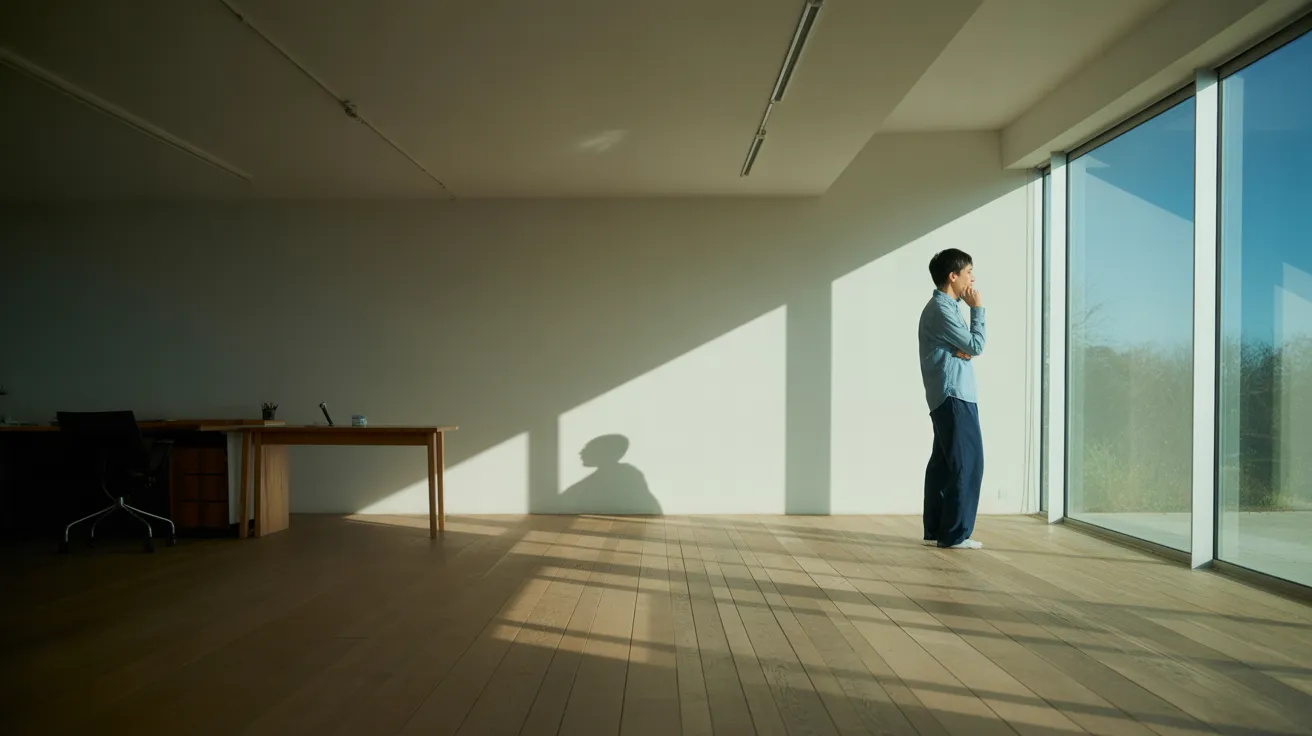
You wake up with the best of intentions. Today will be the day you meditate, journal, exercise, and eat a healthy breakfast, all before your first meeting. You’ve read the articles and seen the videos about the morning routine for success. You feel motivated. But then the alarm sounds a little too early, an urgent email pops up on your phone, and the allure of ten more minutes of sleep wins. By the time you’re rushing out the door, coffee in hand, the grand morning routine is a distant memory, replaced by a familiar whisper of guilt.
If this sounds familiar, you are not alone, and it is not a personal failing. Especially for those of us living in busy, urban environments, our days are a relentless onslaught of decisions, notifications, and demands. We start the day with a finite reserve of willpower, and every choice—from what to wear to which train to catch—depletes it. Relying on sheer willpower to build new morning habits is like trying to build a sandcastle during high tide. The environment is simply too powerful.
The solution isn’t more willpower. It’s less friction. It’s not about grand, sweeping changes that lead to burnout. It’s about designing a system of tiny, almost effortless steps that quietly and consistently move you toward the person you want to become. This is the heart of effective habit building. In this guide, we won’t just list habits. We will give you a gentle, realistic framework for making them stick, for good. We will explore five foundational morning habits that can anchor your day, but more importantly, we’ll show you how to integrate them into your life without the struggle. Forget the all-or-nothing mindset. Let’s build something durable, together.
📚 Table of Contents
- Understanding the Engine of Habit: The Loop and Your Identity
- Designing Your Morning Routine: The Four Pillars of Durability
- Pillar 1: Choose Your Minimum Viable Action
- Pillar 2: Conduct a Friction Audit
- Pillar 3: Engineer Your Environment with Cues
- Pillar 4: Use Gentle Accountability
- Safeguarding Your Progress: How to Handle Setbacks
- Plan for Relapse: The “If-Then” Strategy
- Beware the “All-or-Nothing” Trap of Streak Psychology
- Resetting Without Shame
- Putting It All Together: Worked Examples in Prose
- Example 1: The Evening Wind-Down Routine (Setting Up Your Morning for Success)
- Example 2: The Morning Focus Primer Routine
- Frequently Asked Questions About Habit Building
- How long does it really take to form a new habit?
- What should I do on travel days or when I’m sick?
- I was doing great, but now I’ve hit a plateau. What’s wrong?
- Can I try to build all five of these morning habits at once?
- Your First Steps to a Transformed Morning
Understanding the Engine of Habit: The Loop and Your Identity
Before we can build better habits, we need to understand how they work. We often think of habits as being driven by discipline, but the truth is they are neurologically ingrained shortcuts. Your brain is an efficiency engine; it loves to automate repeated behaviors to conserve mental energy. This automation process is known as the habit loop.
The Simple Science: Cue, Action, Reward
At its core, every habit follows a simple, three-step neurological pattern. Understanding this is the first step toward redesigning your own behaviors. Let’s call it the “Cue, Action, Reward” model.
First, there is the Cue. This is the trigger that tells your brain to go into automatic mode and which habit to use. A cue can be a time of day (waking up), a location (your kitchen), an emotional state (feeling stressed), or the preceding action in a sequence (finishing brushing your teeth).
Second, there is the Action. This is the habit itself—the behavior you perform. It can be physical (drinking a glass of water), mental (recalling something you’re grateful for), or emotional (taking a deep breath instead of reacting in anger).
Finally, there is the Reward. This is the positive feedback that tells your brain, “Hey, this loop was worthwhile. Let’s remember it for the future.” The reward satisfies a craving. It might be the feeling of hydration, the sense of calm after a deep breath, or the satisfaction of checking an item off a list. When the reward is satisfying, your brain begins to associate the cue with that reward, strengthening the loop until the action becomes second nature.
Think about your morning coffee. The cue might be the sound of your alarm or walking into the kitchen. The action is brewing and drinking the coffee. The reward is the jolt of caffeine, the warmth of the mug, and the comforting ritual. This loop is so powerful that the cue alone can trigger a craving for the reward before you even take the action. Our goal is to consciously design new loops for the best morning habits.
Beyond Actions: The Power of Identity-Based Habits
Now, here is the secret that makes habits truly last. It’s not just about what you do; it’s about who you believe you are. This is the concept of identity-based habits. Many of us try to change our habits by focusing on the outcome (“I want to lose 20 pounds”) or the process (“I will go to the gym three times a week”). This can work, but it’s fragile because it’s not tied to our self-image.
A more powerful approach is to focus on your identity. Instead of “I want to read more,” the goal becomes “I want to be a reader.” Instead of “I need to meditate,” it’s “I am a calm and mindful person.” Every time you perform a small action that aligns with this new identity, you are casting a vote for that version of yourself. Reading one page of a book? That’s a vote for being a reader. Meditating for one minute? That’s a vote for being a mindful person. Drinking a glass of water first thing? You’re casting a vote for being a healthy person who prioritizes their well-being.
The goal is not to achieve a perfect morning routine for success overnight. The goal is to start casting small, consistent votes for the person you wish to become. The actions will reinforce the identity, and the identity will, in turn, make the actions feel natural and authentic. This is how you build habits that aren’t just things you do, but are a part of who you are. This foundational concept is supported by decades of psychological research, which you can explore further through resources like the American Psychological Association.

Designing Your Morning Routine: The Four Pillars of Durability
Armed with an understanding of the habit loop and identity-based goals, we can move from theory to practice. Designing a durable morning routine isn’t about finding the “perfect” set of habits. It’s about creating a system that works for your life, right now. This system rests on four pillars: starting impossibly small, removing friction, designing your environment, and building in accountability.
Pillar 1: Choose Your Minimum Viable Action
The single biggest mistake people make when building morning habits is starting too big. We declare we’ll meditate for 20 minutes, run three miles, and write 1,000 words before 7 a.m. This initial burst of motivation is exciting, but it’s unsustainable. On a day when you’re tired or stressed, that high bar feels insurmountable, and you end up doing nothing at all. This is where the minimum viable action comes in.
A minimum viable action (MVA) is the smallest possible version of your desired habit, one that is so easy you can’t say no. It’s laughably simple.
- Instead of “meditate for 20 minutes,” your MVA is “take one mindful breath.”
- Instead of “do a 30-minute yoga session,” your MVA is “roll out your yoga mat.”
- Instead of “write three pages in my journal,” your MVA is “write one sentence.”
The purpose of the MVA is not to achieve a big result in one day. It is to cast a vote for your new identity and to show up, especially on the days you don’t feel like it. Showing up and taking one mindful breath reinforces that you are a mindful person. Writing one sentence reinforces that you are a writer. The MVA keeps the habit loop turning and builds the most crucial habit of all: consistency. You can always do more, but you must meet the minimum.
Pillar 2: Conduct a Friction Audit
Friction is anything that stands between you and your desired action. It’s the number of steps, the time it takes, or the mental energy required. To make good habits easier to adopt, you must ruthlessly decrease their friction. Conversely, to break bad habits, you increase their friction.
Let’s design a friction audit for a few of the best morning habits we’ll focus on: hydration, movement, planning, stillness, and learning.
Habit: Drink a glass of water.
- High Friction: Waking up, walking to the kitchen, finding a clean glass, filling it with filtered water, then drinking it.
- Low Friction: Placing a full water bottle on your bedside table the night before. It’s the first thing you see and touch.
Habit: 5 minutes of stretching.
- High Friction: Yoga mat is in the closet, you need to change into workout clothes, you have to find a video to follow.
- Low Friction: Lay your yoga mat on the floor beside your bed before you go to sleep. You literally have to step over it in the morning.
Habit: Write down one priority for the day.
- High Friction: Your journal is in another room, you can’t find a pen, you have to think hard about what to write.
- Low Friction: Place your journal and a pen on your kitchen counter next to the coffee maker. The single task is just to write one thing.
Take 10 minutes to walk through your desired routine and ask at every step: “How can I make this one step easier?” Every second you shave off, every decision you remove, makes your success more likely.
Pillar 3: Engineer Your Environment with Cues
Your environment is the invisible hand that shapes your behavior. The most disciplined people are not masters of willpower; they are masters of their environment. They design their surroundings to make good habits the path of least resistance. This goes hand-in-hand with reducing friction. It’s about creating powerful, unmissable cues.
This is where another powerful technique, habit stacking, comes into play. Habit stacking links your new desired habit to an existing one that is already firmly established. The existing habit becomes the cue for the new one. The formula is simple: “After [Current Habit], I will [New Habit].”
Let’s build a small stack:
- After my alarm goes off, I will drink the glass of water on my nightstand (Stacking on the cue of the alarm).
- After I finish my water, I will step onto the yoga mat beside my bed and stretch for one minute (Stacking on drinking water).
- After I finish stretching, I will sit on the mat and take three deep breaths (Stacking on stretching).
- After I brush my teeth, I will write one sentence in my journal (Stacking on a deeply ingrained habit).
This chain removes the need to remember what to do next. The completion of one action automatically triggers the next. Your environment (the water on the nightstand, the mat on the floor) and your existing routine become the system, freeing your mind and preserving your willpower for more complex tasks later in the day.
Pillar 4: Use Gentle Accountability
We are social creatures, and we are more likely to follow through on commitments when we feel a sense of accountability to others. However, this doesn’t have to mean intense pressure. Gentle accountability can be a powerful motivator.
This could be as simple as telling a friend or partner, “My goal is to read one page of a book every morning this week.” Just the act of stating the intention aloud can increase your commitment. You could also find a “habit buddy” and check in with a simple text each morning: “Done.” No judgment, just a quiet signal of mutual support. Habit tracking apps can also serve as a form of accountability, providing a visual representation of your consistency that you won’t want to break. The key is to find a method that feels supportive, not stressful. The goal is encouragement, not shame.

Safeguarding Your Progress: How to Handle Setbacks
Building a new morning routine is not a linear process. There will be sick days, travel, stressful weeks, and mornings when you simply forget. The difference between someone who succeeds and someone who gives up is not that the successful person never fails; it’s how they respond to that failure. A robust system of habit building must include a plan for when things go wrong.
Plan for Relapse: The “If-Then” Strategy
Life is unpredictable. Instead of hoping disruptions won’t happen, plan for them. This is known as “if-then planning” or “implementation intentions.” You create a specific plan for how you’ll handle a potential obstacle before it occurs. This pre-decision making saves you from having to rely on in-the-moment willpower when you’re already tired or stressed.
Here are some examples:
- If I wake up late and only have 5 minutes, then I will just drink my glass of water and take three deep breaths.
- If I am traveling and staying in a hotel, then I will do my one minute of stretching on the floor as soon as my feet touch the ground.
- If I feel too sick to do my routine, then my only job is to rest, and I will resume my MVA tomorrow without guilt.
By having a plan, a missed day doesn’t become a catastrophe. It’s just a planned deviation. You followed the plan for that specific scenario, which is a success in itself.
Beware the “All-or-Nothing” Trap of Streak Psychology
Tracking your streak—the number of consecutive days you’ve performed a habit—can be incredibly motivating. Seeing that number climb from 7 to 30 to 100 days provides a powerful sense of reward and progress. However, it has a dark side: the all-or-nothing mindset. When you inevitably miss a day, the broken streak can feel so devastating that it leads to complete abandonment of the habit. “I’ve already ruined it,” you might think, “so what’s the point of starting again?”
The solution is to reframe the goal. The goal is not a perfect, unbroken streak. The goal is a high percentage of success and a quick recovery from failure. This is where the most important rule of habit building comes in: never miss twice.
Missing one day is an accident. It’s part of life. Missing two days in a row is the start of a new, undesirable habit. Your entire focus after a missed day should be on getting back on track the very next day, no matter how small the action. Did you miss your morning stretch today? Fine. Tomorrow, your only priority is to do it, even if it’s for just 30 seconds. This builds the critical identity of someone who is resilient, not someone who is perfect.
Resetting Without Shame
Shame is the enemy of progress. When you miss a day, your inner critic might pipe up with accusations of being lazy, undisciplined, or a failure. This internal narrative is not helpful; in fact, it’s counterproductive. It drains your energy and motivation, making it even harder to start again.
Instead, practice self-compassion. Treat yourself as you would treat a good friend who is trying their best. Acknowledge the misstep without judgment. Say to yourself, “Okay, that didn’t happen today. It’s not ideal, but it’s okay. I am a person who gets back on track.” Analyze what went wrong with curiosity, not criticism. Was the friction too high? Did an unexpected event derail you? Use the information as data to improve your system. Maybe your MVA is still too large, or you need a better “if-then” plan. Every setback is an opportunity to learn and refine your approach. Remember, consistency is not about perfection. It’s about returning, again and again, to the practice.

Putting It All Together: Worked Examples in Prose
Let’s see how these principles come together in a real-world context. These are not rigid prescriptions, but illustrations of how you can weave tiny habits into a seamless routine. Notice how one action flows into the next, guided by environmental cues and habit stacking.
Example 1: The Evening Wind-Down Routine (Setting Up Your Morning for Success)
The best morning routine often begins the night before. This evening routine is designed to reduce tomorrow’s friction and signal to your body and mind that it’s time to rest. At 9:30 p.m., a gentle alarm on Sarah’s phone goes off, not with a jarring sound, but with a quiet chime labeled “Wind Down.” This is her cue. She finishes what she’s doing and walks into the kitchen. There, she takes her water bottle and fills it, placing it on her bedside table—her first act of kindness for her future self. Next to the bottle, she places the book she is reading. Back in the living room, she unrolls her yoga mat and leaves it beside her bed. She then heads to the bathroom. After she brushes her teeth, her established habit, she opens the journal and pen that live on the small counter. She doesn’t have to write a novel; her MVA is to write down one thing she’s grateful for from the day. This simple action shifts her mind from the day’s stresses to a place of positivity. Finally, she gets into bed, plugs in her phone across the room to increase the friction of snoozing, and reads just one page of her book. The entire process takes less than ten minutes, but it has perfectly set the stage for a successful morning.
Example 2: The Morning Focus Primer Routine
Mark’s alarm goes off at 6:30 a.m. His phone is across the room, so he has to get out of bed to turn it off. This single piece of friction-based design prevents him from hitting snooze. As he walks back to his bed, he sees the full water bottle Sarah (his partner) or he himself placed there the night before. He picks it up and drinks it all while standing and looking out the window. This is his anchor habit. Once the bottle is empty, he immediately steps onto the yoga mat he laid out. He doesn’t do a full workout; he simply does a few gentle stretches for sixty seconds, focusing on his back and hamstrings. This is his body habit, waking up his physical self. After the stretch, he sits on the mat, closes his eyes, and takes five deep, slow breaths. He’s not trying to clear his mind, just to observe his breath. This is his mind habit. He then walks to his desk, where his notebook and favorite pen are waiting. He opens it and writes down the single most important task for the day. Not a to-do list, just one “win” for the day. This is his direction habit. This whole sequence is finished before he’s even thought about checking email or brewing coffee. It has taken less than five minutes, but he has already hydrated, moved his body, calmed his mind, and set his intention. He has started his day proactive, not reactive, embodying the identity of a focused and intentional person.

Frequently Asked Questions About Habit Building
It’s natural to have questions as you start this journey. Here are answers to some of the most common queries we receive about creating a durable morning routine.
How long does it really take to form a new habit?
You may have heard the popular myth that it takes 21 days to form a habit. While a catchy number, research shows it’s much more variable. A study published in the European Journal of Social Psychology found that, on average, it takes about 66 days for a new behavior to become automatic. However, the range was huge—from 18 days to 254 days—depending on the person, the behavior, and the circumstances. The key takeaway is not to fixate on a magic number. Focus on the principle of “never miss twice.” Whether it takes you 30 days or 100 days, the process is the same: show up, perform your minimum viable action, and be kind to yourself when you falter. Consistency is more important than speed.
What should I do on travel days or when I’m sick?
This is where your “if-then” planning and your minimum viable action are your best friends. The goal on disrupted days is not performance; it’s identity maintenance. If you’re sick, your habit might simply be to say, “I am a healthy person, so today I will rest.” That is a success. If you’re traveling, shrink your MVA even further. Can’t do your usual stretching? Do 30 seconds of neck rolls. Don’t have your journal? Open the notes app on your phone and type one sentence. By doing a tiny version of your habit, you are still casting a vote for your desired identity and keeping the thread of consistency intact. This makes it infinitely easier to return to your full routine when your circumstances return to normal.
I was doing great, but now I’ve hit a plateau. What’s wrong?
Plateaus are a normal and expected part of any growth process. They don’t mean you’re doing something wrong. Often, a plateau is a sign that the initial novelty has worn off and the habit is becoming integrated. It can feel boring. This is a critical moment. Instead of seeking a new, more exciting habit, this is the time to lean into the system. Remind yourself of your “why”—the identity you are building. You can also introduce small variations to keep it fresh. If you meditate for one minute, try a different type of breathing. If you stretch, try a new stretch. Another strategy is to re-evaluate the reward. Is it still satisfying? Sometimes adding a small, immediate reward after your routine—like savoring your favorite tea—can help reinforce the loop when internal motivation wanes.
Can I try to build all five of these morning habits at once?
It’s tempting to overhaul your life in one go, but it’s generally more effective to start with just one or two new habits. The best approach is to choose one “anchor” habit—like drinking a glass of water—and make it non-negotiable for a few weeks. Once that feels completely automatic, you can use habit stacking to add the next one. For example, once drinking water is effortless, add the one minute of stretching immediately after. By adding habits incrementally, you give your brain time to automate each one without overwhelming your willpower. This slow, layered approach is far more likely to lead to a rich and sustainable morning routine for success than trying to do everything at once. Remember, the journey of a thousand miles begins with a single, well-established step.

Your First Steps to a Transformed Morning
We’ve covered the psychology, the strategy, and the safeguards for building a life-changing morning routine. It’s not about becoming a different person overnight. It’s about making small, intelligent choices that compound over time. It’s about designing a system that supports your goals instead of relying on a finite supply of willpower. The most powerful morning habits are the ones you actually stick with, and the key to sticking with them is to start small and build a process that is gentle, forgiving, and rooted in the identity you wish to cultivate. The consistency of these small actions can have a profound impact on your overall health and well-being, a principle widely supported by public health organizations like the National Institutes of Health.
You have the blueprint. Now, it’s time to take the first, simple step. Don’t try to implement everything you’ve read today all at once. That would violate the very principles we’ve discussed. Instead, here are three concrete actions you can take over the next week to begin your journey.
Your Next Actions:
1. Choose Your One Thing. For the next seven days, commit to just one habit. Not five. One. Choose the easiest one that feels most resonant to you. Perhaps it’s placing a glass of water by your bed tonight. Perhaps it’s writing one sentence in a notebook. Make this your single point of focus.
2. Define Your Minimum Viable Action. Be honest and make it ridiculously easy. If your goal is to meditate, your MVA is to sit and take one single deep breath. Write it down: “My minimum viable action is to…” This clarity is crucial. It’s your baseline for success.
3. Perform a Friction Audit Tonight. Before you go to bed, walk through the steps of your single chosen habit for tomorrow morning. What can you do right now to make it 10% easier? Can you lay out the notebook? Fill the water bottle? Set out your yoga mat? This five-minute investment tonight will pay huge dividends tomorrow morning when you’re tired.
That’s it. This is your starting point. Begin with these small steps, practice self-compassion, and focus on the identity you are building with each tiny action. Your future self will thank you for it.
Disclaimer: The information provided in this article is for informational purposes only and is not intended as a substitute for professional medical or psychological advice, diagnosis, or treatment. Always seek the advice of your physician or other qualified health provider with any questions you may have regarding a medical condition or mental health.






